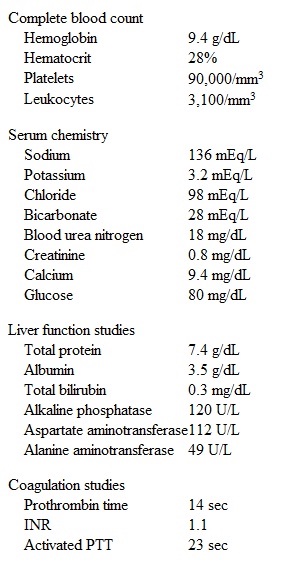A 55-year-old man comes to the emergency department due to blood-tinged vomiting. The patient was at a party the evening prior to presentation and consumed a large quantity of alcohol. After leaving, he developed symptoms of nausea and retching, followed by vomiting several hours later. The emesis was initially clear but then became intermixed with small amounts of blood. He has no abdominal pain, weight loss, or changes in stool. The patient has a history of alcoholism and was admitted for acute pancreatitis a few months ago. He currently takes no medications or over-the-counter supplements. The patient drinks 4 or 5 beers daily but does not use tobacco or illicit drugs. Temperature is 36.7 C (98.1 F) , pulse is 88/min, and respirations are 16/min. Physical examination shows dry mucous membranes, flat jugular veins, clear lung fields, and normal S1 and S2. The abdomen is soft and tender in the midepigastrium with no rebound tenderness or rigidity. Bowel sounds are normal. There is moderate splenomegaly without hepatomegaly. No edema is present. Laboratory results are as follows:  The patient undergoes an esophagogastroduodenoscopy that reveals several small, erythematous erosions at the gastroesophageal junction as well as hyperemia and petechiae throughout the gastric mucosa. Incidentally, varices are seen in the fundus of the stomach but no esophageal varices are seen. Which of the following is the most likely cause of this patient's varices?
The patient undergoes an esophagogastroduodenoscopy that reveals several small, erythematous erosions at the gastroesophageal junction as well as hyperemia and petechiae throughout the gastric mucosa. Incidentally, varices are seen in the fundus of the stomach but no esophageal varices are seen. Which of the following is the most likely cause of this patient's varices?
A) Budd-Chiari syndrome
B) Constrictive pericarditis
C) Hepatic veno-occlusive disease
D) Portal vein thrombosis
E) Splenic vein thrombosis
Correct Answer:
Verified
Q264: A 15-month-old girl is brought to the
Q265: A 22-year-old woman comes to the physician
Q266: A 13-year-old girl is brought to the
Q267: A 68-year-old man with coronary artery disease
Q268: A 35-year-old woman comes to the office
Q270: An 84-year-old man is being treated for
Q271: A 50-hour-old boy is in the nursery
Q272: A 58-year-old man with a 16-year history
Q273: A 2-year-old girl is brought to the
Q274: A 63-year-old man comes to the clinic
Unlock this Answer For Free Now!
View this answer and more for free by performing one of the following actions

Scan the QR code to install the App and get 2 free unlocks

Unlock quizzes for free by uploading documents